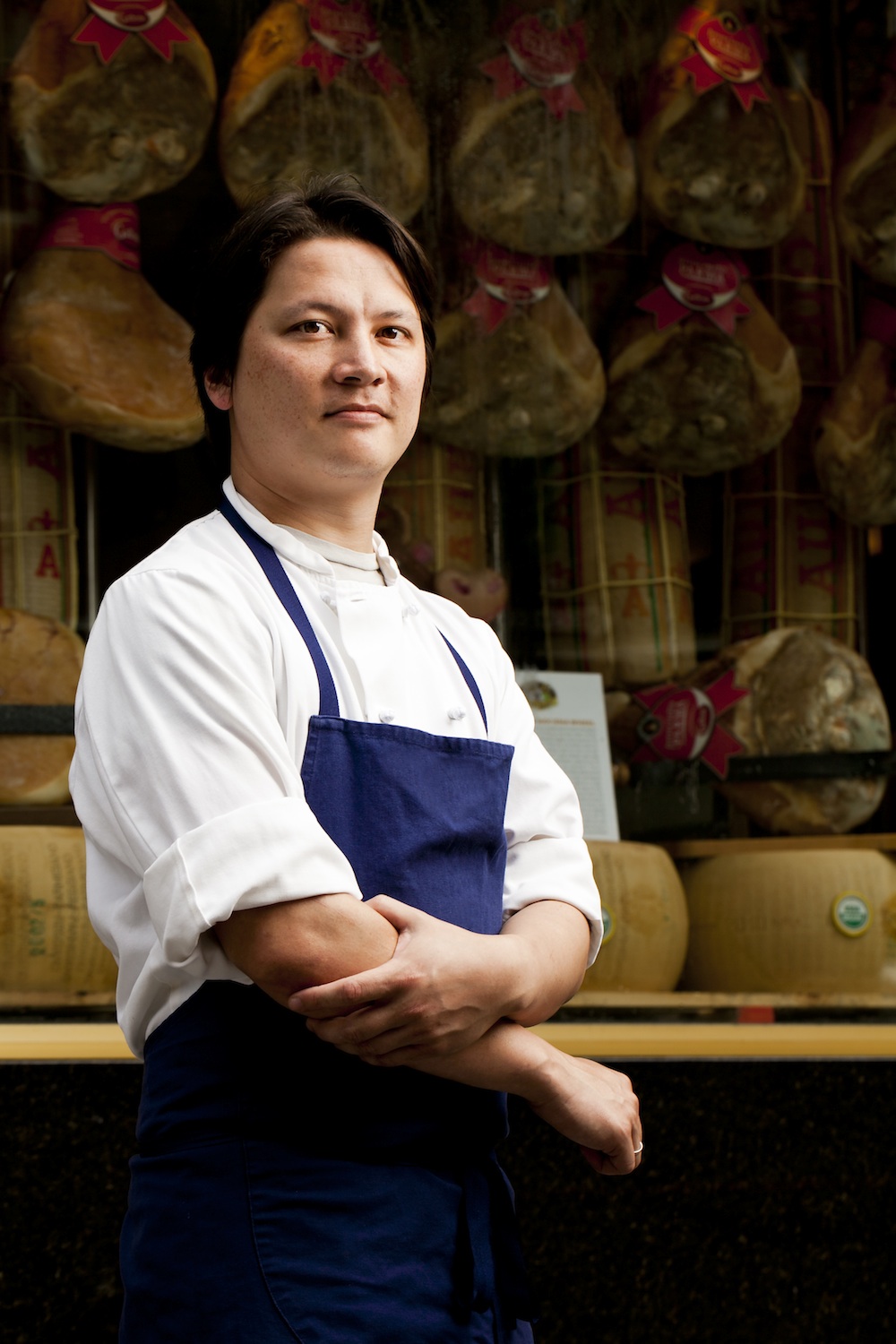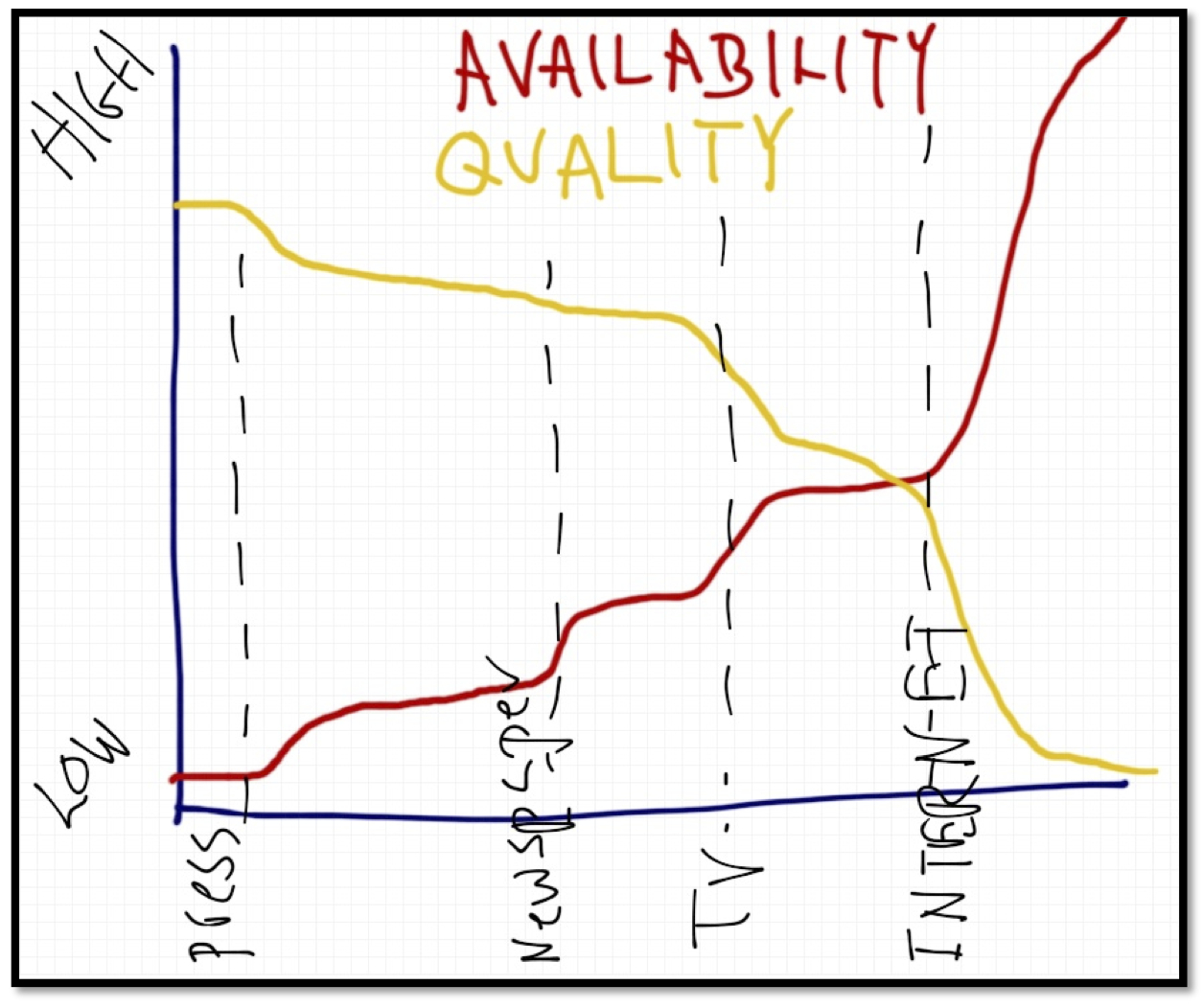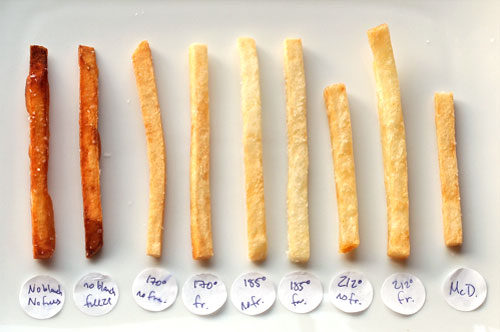loading...
Please join me in welcoming Kenji Lopez-Alt, the Chief Creative Officer at Serious Eats. My review of his keynote speech to the attendees of this year’s Food Blog South Conference follows. Here, Kenji discusses the Serious Eats philosophy, his work at the website, and the hallmarks of good food blogs.
Please note: in about 75-minutes, Kenji fit in more information than any keynote speaker I’ve ever seen, and to help make sense of his 54-pages of notes (thank you for sharing them Kenji!) plus the 10+ pages I recorded during the talk, I’ve chosen to divide this article into 5-part installments (a real first for Clearly Delicious). Check back each day this week for one of Kenji’s key points and/or read on for Kenji’s call to food writers that they take full advantage of the Internet’s potential when crafting their posts.
Also, a very big thank you to my writing / editing interns—Erica deVeer, Tara Hebert, Amy Laws, & Meredith Quinn—for helping make this article as clear, useful, and informative as Kenji’s advice. Kenji’s food blogging philosophy is very important to me, and I couldn’t be more pleased with your notes & helpful revisions to my article. What an incredible way to start the spring program at Clearly Delicious! Now, here’s Kenji Lopez-Alt. —Helana
—

Kenji Lopez-Alt is the Chief Creative Officer at Serious Eats. Famous for his work in “The Burger Lab,” Kenji blends “geekery,” recipes, and food writing in an unmistakable, empirically-based style . Whether he’s using triangle tests or the scientific method, Kenji shows readers how blogging is more than recipes or fancy pictures, but an opportunity to move beyond trendy blogging strictures with a pinch of experimentation. In fact, distinguishing your writing may be as simple as a bunsen burner or erlenmeyer flask.
Photo by Peter Tannenbaum
—
“The internet is new and exciting. There are so many ways to share and discover information, and if you aren’t utilizing it fully, if you are still treating it like an old media source, then you aren’t actualizing your full potential or the potential of your readers.”
– Kenji Lopez-Alt
I believe it’s important to note that Kenji Lopez-Alt opened his talk to the 2013 Food Blog South audience by theorizing food bloggers’ potentials: unlike the old-school print mediums of twentieth-century periodicals (Cook’s Illustrated, Gourmet, and the New York Times), food writers today—especially those online—must push to reconceive what it is that they (or, we) do.
As beautiful as our posts or as expensive as our DSLR lenses may be, food bloggers are not the 90s Ruth Reichls of the world, capable of changing a restaurant’s popularity with a single article or re-defining food trends with their chopsticks.
Rather, we makeup the newest, current generation of writers who, for the first time in the history of cookbooks or food writing, have the potential for revising the ways readers think and talk about food if only because we are members of their online communities. In so many ways, we are very much unlike the food writers before us.
[ Wait—Maybe we are capable of influencing a restaurant’s success, but in our contexts. In the words of Whitman, “Do I contradict myself? Very well, then I contradict myself, I am large, I contain multitudes.”]
And this is where Kenji’s talk becomes especially interesting. Variables such as reader involvement, blog communities, content quality, and a blogger’s authority must always be taken into consideration as we write our posts.
But, I’m probably getting ahead of myself.
Like retired New York Times Food Critic Ruth Reichl, online food writers of all levels of exposure author thousands of conversations each day. They raise ethical issues and stir up controversy, generate debates, and, sometimes, just act badly when it comes to restaurants and the places they eat. As what Kenji calls the “new gatekeepers,” food bloggers have a series of options before them:
How much do food bloggers engage with their online and physical communities?
What are the hallmarks of good content?
And, how do online food writers keep content simultaneously good and professional?
These questions must always be asked (or, at least considered) since rapidly changing technologies continue to adjust how we think or read about food. As a fairly young generation of writers, we’ve already played a huge role in redefining the ways people access the food they’re ultimately eating (or, planning to eat). How your mother, my father, or somebody’s cousin considers the foods they put on their plates (or, might put on their plates, as in, what restaurants to go to or recipes to try) exists in a completely different sphere than word of mouth at your neighborhood haunt.
Let me put it this way: Kenji points out that as new ways to discover and share information become increasingly available, the quality of this content has no choice but to decline:

Pictured: one of Kenji’s hand-drawn graphics from his keynote address to FBS2013 attendees.
Y-Axis: low to high; X-axis: various food writers and where they publish.
(Note how the Internet offers high levels of availability but intersects with lower levels of quality.)
This online terrain is troubled, massive, and wildly informed. Who becomes a voice worth listening to? And, what do they have to say?
Especially in a world, where, everyone’s a critic?
—
Use & Abuse:
Understanding Expertise
—
Before I offer Kenji’s advice on the hallmarks of good food writing or engaging our communities, I think I should first point out what it is we should not do:
(1) Misuse social media or its mechanics
(2) Troll or target community members
[Note: Kenji didn’t stress these two points in his talk the way I’ve spotlighted them above, but I list the unpredictable nature of social media here so we can move forward in envision what “good” food writing looks like in an online world that can be potentially anonymous and ugly.]
In this sphere, food writing has never had more potential for including individual voices, and one blogger’s (or reviewer’s) voice is now capable of doing this and, well, hilariously this:
http://youtu.be/INDtZifMsFM
A clip from this season’s Portlandia in which Candace & Toni, co-owners (and life-partners) of Women & Women First Bookstore, discover a negative review on Yelp…and…well…do something about it.
This “high availability, low quality” environment creates opportunities in which we, as writers, run the risk of engaging our communities in negative ways, or falling down waiting rabbit holes a little too easily. Christopher Kimball famously targeted these dangers when dubbing online writers as the Internet’s “million instant pundits,” sailing aboard a “ship of fools” of which he wanted no place in the Carnival-style buffet line.
Citing former boss Christopher Kimball’s same 2009 Op-Ed for the New York Times, Kenji summarized the magazine exec’s anxieties over how the Internet has affected industry publishing— “Will I have a job next year?” —quoting Kimball’s argument that the “world needs fewer opinions and more thoughtful expertise—the kind that comes from real experience, the hard-won blood-on-the-floor kind.” After all, this is an editor who ends his opinion piece not in his own words, but in (“expert”) Julia Child’s famous, “Where did you train, dear?”
Wearing some sort of invisible ninja goggles, Kenji put Kimball’s commentary into perspective for us:
“Now you can imagine . . . the reaction this kind of talk stirred up on the Internet, which, incidentally, was where most people were reading it, NOT in the printed pages of the newspaper.”
– Kenji Lopez-Alt
Kenji’s advice?
Let’s redirect our new-found power for good. Not just the good of our community and industry, but also “good content.”
And, let’s think about what “good” can actually mean as writers who craft and publish articles that respect our readers’ intelligence. In Ed Levine’s response to Kimball’s piece, he (like Kenji) points out the unspoken grey area our famous Cook’s publisher fails to mention:
“The democratic aspect of the internet that’s so terrifying to the old guard is not one that means that every opinion is equal. It just means that every opinion can be equally heard.”
-Ed Levine
I would add to Kenji’s, Levine’s, and Kimball’s remarks that every opinion is open to new definitions of “expertise” as well.
If old-school publishers like Kimball are so concerned with the mantra, “where did you train dear?” then I’d like to respond— “on a lobster boat, every day, for 7 years” —not at the Cordon Bleu, where red-faced, high-blood-pressured chefs yelled at me in their native tongue, thinking I could not understand their language.
Plus, Kimball’s “hard-won blood-on-the-floor kind” of experience is wildly un-literal in its claims—those of us who have actually seen “blood on the floor” because we’ve cooked and trained in traditionally laborious positions only to be shafted as “manual laborers” and not experts disconnects highly from who, really, might be preparing our food.
And, based on this definition, aren’t lobsterman who untie their boats each morning only to “watch out for the claws” as they apply rubber bands the real experts? Not to get too specific, but I’m pretty sure the best restaurants I’ve eaten at have chefs who fish and catch their Monday lunch special (and no, I’m definitely not referring to David Pasternack from New York City’s Esca).
[Steps off soapbox.]
Personal interests aside, what I do know, for me, is that my school of expertise might be my current swampy bayous outside of New Orleans, or the rocky coasts of southern Maine, and, for Kenji, they may very well have been numerous labs at MIT.
But, experts, we are, nonetheless.
—
Want more Kenji? See tomorrow’s installment, Part 2: “Gatekeepers,” from Kenji’s talk, “I’ve Got a Test for That”: Notes from the Keynote, from the 2013 Food Blog South Conference.
Directory:
Or, See: Part 1: “I’ve Got a Test for That” (above)
Part 3: “The Good, the Bag, & the Plain Weird”
Part 4: “The Architecture of a Good Blog Post”
Part 5: “What Crazy thing Can I Do?”
—
Follow me on Pinterest: http://pinterest.com/helana/
Twitter: https://twitter.com/DancesWLobsters
Facebook: https://www.facebook.com/pages/Clearly-Delicious/103136413059101
Tumblr: http://clearlydelicious.tumblr.com/
Instagram: http://instagram.com/helanabrigman
Part 1: "I've Got a Test for That," Notes from the Keynote, Kenji Lopez-Alt of Serious Eats,

3 Comments
Jaden
March 18, 2013 at 12:36 pmLoving your series – I wish I would have attended the conference!
Helana Brigman
March 18, 2013 at 1:36 pmThanks so much for the kind feedback Jaden! Kenji is an inspiring speaker, and an even better blogger. He’s quite the myth, the man, and the blogging legend.
Speaking of blogs – I just *love* Steamy Kitchen. I know I’ll be stopping by sometime later today to see what you’re up to. You were definitely one of the very first blogs I began reading years ago in college–talk about great content!
Clearly Delicious » Part 5: “What Crazy Thing Can I Do?” Kenji Lopez-Alt of Serious Eats
March 18, 2013 at 6:36 pm[…] Got a Test for That”: Notes from the Keynote at Food Blog South (2013) ends here (see parts 1, 2, 3, & 4 if you need to catch up). […]